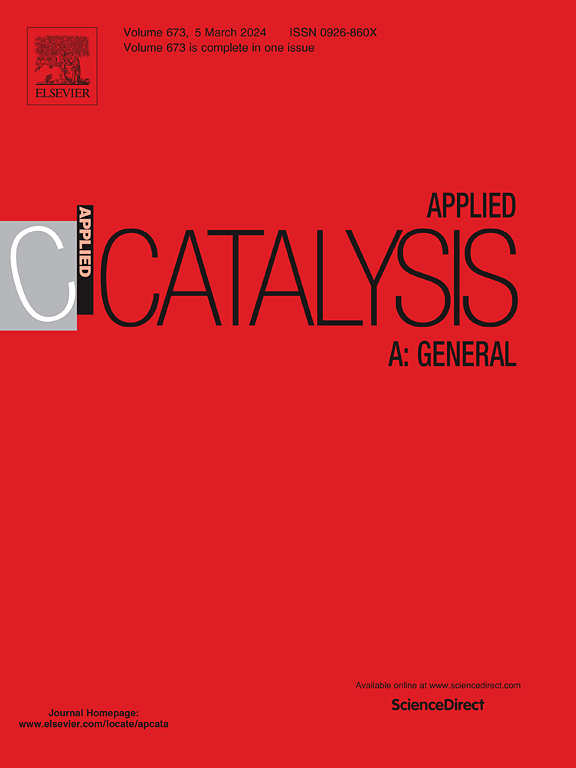Polyoxometalates as catalyst precursors for reverse water gas shift
IF 4.7
2区 化学
Q2 CHEMISTRY, PHYSICAL
引用次数: 0
Abstract
The reverse water gas shift (RWGS) was studied in the presence of catalysts based on Keggin-type polyoxometalates (POMs) such as heteropoly acids H3PMo12O40 and H3PW12O40 and their Co(II) and Ni(II) salts. Under reaction conditions, molybdenum POMs decomposed to form Mo oxide species, which exhibited high activity, selectivity and resistance to deactivation in the RWGS reaction. The catalysts formed from H3PMo12O40 supported on SiO2, TiO2 and γ-Al2O3 produced CO with 100 % selectivity at 31–33 % CO2 conversion at 600 °C and a CO2:H2 molar ratio of 1:1 (cf. 39 % equilibrium conversion). H3PMo12O40/SiO2 was more active than MoO3/SiO2 with the same Mo loading, revealing a phosphorus enhancement effect on the activity of molybdenum species. This effect can be attributed to the influence of phosphate on the dispersion of the Mo oxide active phase. This is supported by STEM, which shows different morphologies of Mo oxide species in H3PMo12O40/SiO2 and MoO3/SiO2 catalysts. Chemical looping and H2-TPR of fresh and spent Mo catalysts show that the reaction occurs through the redox mechanism involving the reduction of Mo(VI) oxide species to Mo(IV) with H2, followed by reoxidation of Mo(IV) with CO2 to form CO (reverse Mars–van Krevelen mechanism). Contrary to the Mo catalysts, tungsten POMs, exhibited no RWGS activity, which can be attributed to their resistance to reduction.
多金属氧酸盐作为水气反移催化剂前驱体
研究了keggin型多金属氧酸盐(POMs)杂多酸H3PMo12O40和H3PW12O40及其Co(II)和Ni(II)盐催化剂作用下的反水气转换(RWGS)。在反应条件下,钼聚甲醛分解生成氧化钼,在RWGS反应中表现出较高的活性、选择性和抗失活能力。由SiO2、TiO2和γ-Al2O3负载的H3PMo12O40形成的催化剂在600 ℃下,在31-33 %的CO2转化率和1:1的CO2:H2摩尔比(39 %的平衡转化率)下产生的CO选择性为100 %。在相同Mo负载下,H3PMo12O40/SiO2的活性高于MoO3/SiO2,表明磷对钼的活性有增强作用。这种效应可归因于磷酸盐对氧化钼活性相分散的影响。在H3PMo12O40/SiO2和MoO3/SiO2催化剂中,Mo氧化物形态不同。新鲜和废Mo催化剂的化学环和H2- tpr表明,该反应是通过氧化还原机制发生的,其中Mo(VI)氧化物与H2还原为Mo(IV),然后Mo(IV)与CO2再氧化生成CO(逆Mars-van Krevelen机制)。与Mo催化剂相反,钨pom不具有RWGS活性,这可归因于其抗还原性。
本文章由计算机程序翻译,如有差异,请以英文原文为准。
求助全文
约1分钟内获得全文
求助全文
来源期刊

Applied Catalysis A: General
化学-环境科学
CiteScore
9.00
自引率
5.50%
发文量
415
审稿时长
24 days
期刊介绍:
Applied Catalysis A: General publishes original papers on all aspects of catalysis of basic and practical interest to chemical scientists in both industrial and academic fields, with an emphasis onnew understanding of catalysts and catalytic reactions, new catalytic materials, new techniques, and new processes, especially those that have potential practical implications.
Papers that report results of a thorough study or optimization of systems or processes that are well understood, widely studied, or minor variations of known ones are discouraged. Authors should include statements in a separate section "Justification for Publication" of how the manuscript fits the scope of the journal in the cover letter to the editors. Submissions without such justification will be rejected without review.
 求助内容:
求助内容: 应助结果提醒方式:
应助结果提醒方式:


